 |
 |
 |
| |
Does Knowledge Influence Reporting Practices when Screening for Hepatitis C in Pregnant Women?
|
| |
| |
Reported by Jules Levin
IDSA Oct 2-6 2013 San Francisco, CA
Wambui Waruingi MD, Jessica Campf, Nazha Abughali MD
Department of Pediatrics, MetroHealth Medical Center , Case Western Reserve University School of Medicine, Cleveland, Ohio
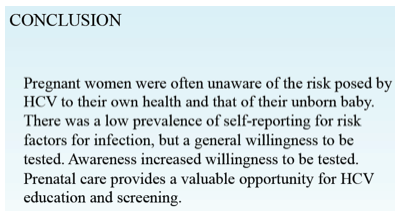
(from Jules: 70% supported Universal Testing]
Background
Currently, pregnant women are tested for Hepatitis C Virus (HCV) only in the presence of risk factors, per current CDC and ACOG guidelines. These risk factors are most often self-reported. There is no consensus for universal screening. Serving a high risk, low socioeconomic status, we hypothesized that our population of pregnant women are ill-informed of HCV, and that this may affect self-reporting practices and willingness to be tested.
OBJECTIVE
To determine the correlation between awareness, risk factor reporting and willingness to be tested for HCV among pregnant women.
METHODS
This was conducted as an IRB-approved, anonymous, cross-sectional survey administered to pregnant women presenting for prenatal care in our institution.
The inclusion criteria was age greater than 18 years of age, English speaking, willingness to participate, able to provide assent and complete questionnaire independently. The questionnaire was completed in the triage area, waiting room or doctor's office. For subjects assenting to participate, no guidance was provided to complete the questionnaire. After completion of the survey, the questionnaire was retrieved from the subject. All the data analyzed using SPSS software.
Program Abstract
Background: Currently, pregnant women are tested for HCV only in the presence of risk factors, as per current CDC and ACOG guidelines. There is no consensus for universal screening, especially in high risk populations. Serving a high risk, low socio-economic status (SES), we hypothesized that our population of pregnant women are ill-informed of HCV, and that this may affect self-reporting practices and willingness to be tested. The objective of this study was to determine the correlation between awareness, risk factor reporting and willingness to be tested for HCV among pregnant women.
Methods: An IRB-approved, anonymous, cross-sectional survey confidentially administered to pregnant women >18 years old between June and September 2011.
Results: 302 women completed the survey. 132/302 (43%) of the study group were African American. 205/302 (68%) were single. 240/302 (80%) of the study population had heard of HCV. Of these, 84/240 (35%) had no knowledge of the modes of HCV transmission. Only 131/240 (55%) could correctly identify at least three modes of transmission. 17/240 (7%) were aware of the long term effects of HCV infection. 121/302 (40%) were aware of the risk of HCV transmission to their unborn child. 98/302 (32%) reported risk factors: 80/302 (27%) had been treated for sexually transmitted diseases, 11/302 (3%) a history of intravenous drug use, 6/302 (2%) had received blood or blood products prior to 1992 and 1/302 (0.3%) current HIV infection. There was no correlation between awareness of HCV and risk factor-reporting. 179/302 (60%) of the study population were willing to be tested for HCV, and 195/302 (65%) advocated for universal testing. There was a strong correlation between the willingness to be tested and knowledge of the modes of transmission [93/131(71%) vs. 38/131(29%); p<0.001], and the knowledge of the long term effects of HCV [94/131 (72%) vs. 37/131 (28%); p=0.001].
Conclusion: Pregnant women were often unaware of the risk posed by HCV to their own health and that of their unborn baby. There was a low prevalence of self-reporting for risk factors for infection, but a general willingness to be tested. Prenatal care provides a valuable opportunity for HCV education and screening.
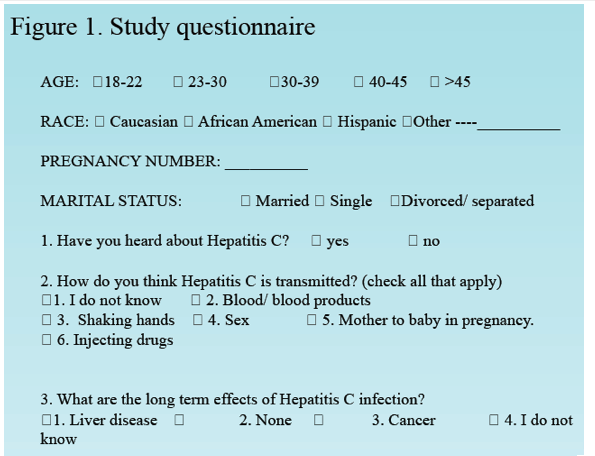
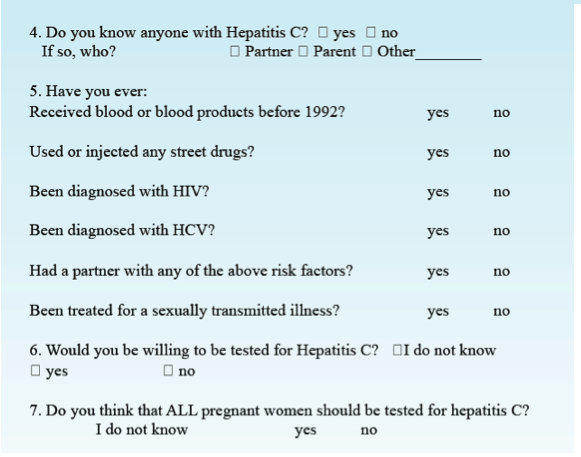
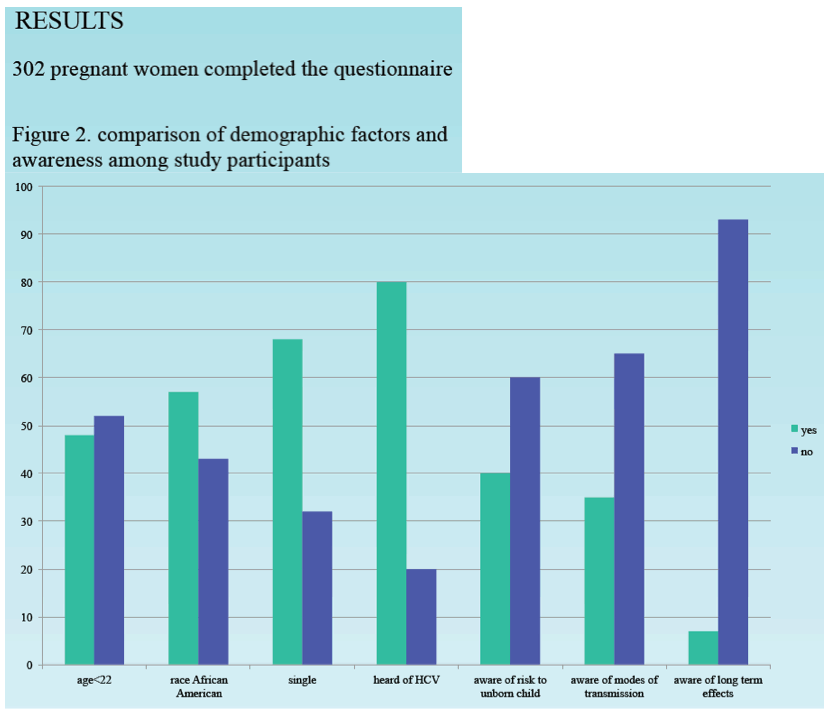
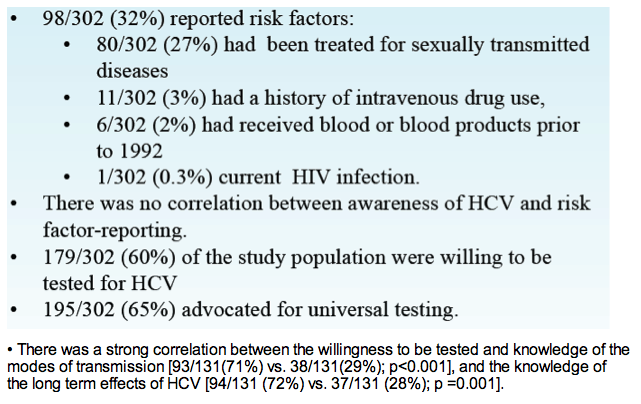

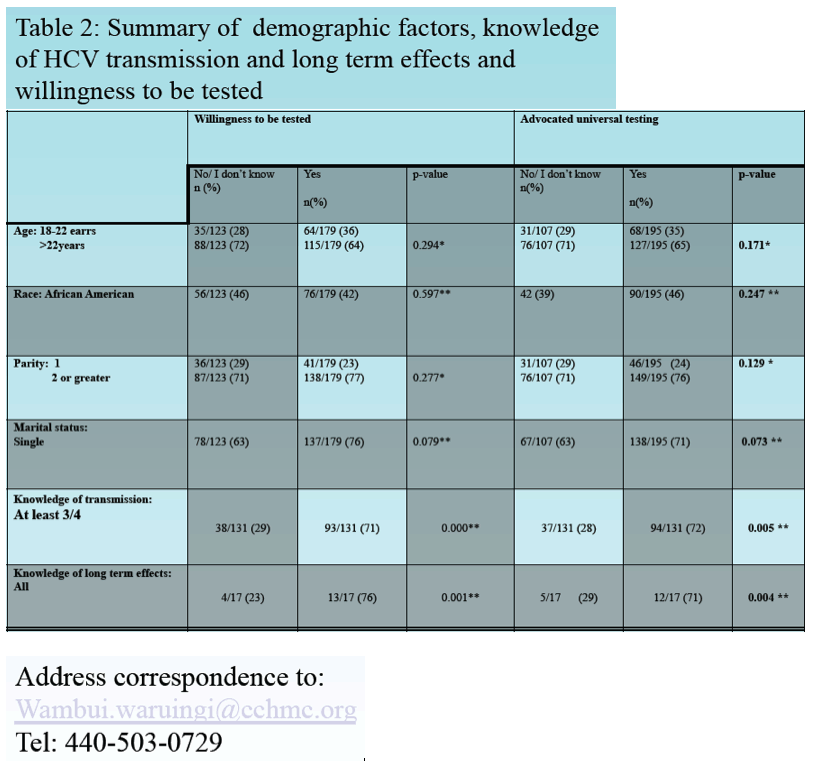
|
| |
|
 |
 |
|
|